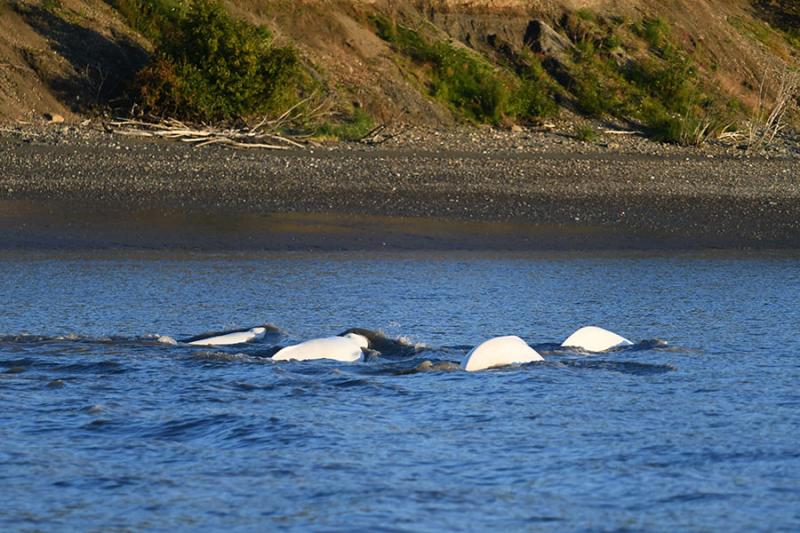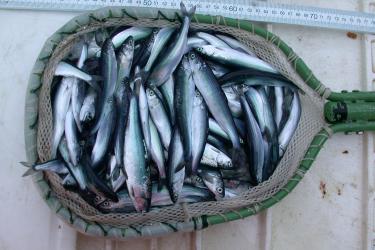Beluga whales are highly social and vocal marine mammals. They use acoustics to find prey, navigate their environment, avoid predators, and maintain group cohesion. For Alaska’s critically endangered Cook Inlet beluga population, these crucial communications may compete with a cacophony of noise from human activities.
“The core critical habitat for these whales is a very noisy area. Commercial shipping, an international airport, military operations, and gas and oil exploration are all concentrated there,” said Arial Brewer, NOAA Fisheries affiliate at the Alaska Fisheries Science Center and Ph.D. student at the University of Washington.
A new study is the first to document the complex vocal repertoire of the Cook Inlet beluga whale population. It is also the first to quantify how ship noise may be masking specific beluga calls in this region. The research was a collaborative effort between NOAA Fisheries Alaska Fisheries Science Center, the University of Washington, and the Alaska Department of Fish and Game. The findings can inform decisions on management and recovery actions related to the effect of shipping noise on this endangered population.
“A fundamental knowledge gap for the Cook Inlet beluga population is how they communicate important information. The first step is to describe their vocal repertoire,” said Brewer, who led the study. “With that information we can begin to understand if their communication is impacted by human-caused noise.”
A Population in Peril
There are 21 recognized populations of belugas worldwide, including five distinct populations in Alaska. The geographically and genetically isolated Cook Inlet beluga population is the smallest, with an estimated 331 individuals. Cook Inlet beluga whales live exclusively in their namesake waters alongside Anchorage, Alaska’s largest city and busiest port.
The Cook Inlet beluga whale population was listed as endangered under the Endangered Species Act in 2008. That led to the designation of critical habitat in 2011. However, the population has remained low. A 2016 recovery plan ranks three threats as the highest level of concern:
- Catastrophic events (e.g., oil spills, mass strandings)
- Human-caused noise
- Cumulative effects of multiple stressors (e.g., pollutants and noise)
Commercial shipping is the most prominent noise source within Cook Inlet, particularly in the upper inlet where the critical habitat is located.
”All of that human-caused noise means the belugas may not hear critical communications from each other, such as predator alarm calls or a mother calling to her calf,” Brewer said.
Cook Inlet belugas may be particularly vulnerable to noise as a stressor.
“Cook Inlet is extremely turbid year-round from glacial runoff. It looks like chocolate milk,” Brewer said. “Acoustic communication is extremely important for this population since visibility is so poor. And, unlike other higher arctic beluga populations, this population is non-migratory, so they are exposed to this noise year-round.”
Cataloging the Vocal Repertoire
Cook Inlet’s extreme turbidity, dramatic tides, rapid currents, and seasonal ice cover make it an extremely challenging place to study belugas. To meet this challenge, one way scientists can monitor these highly vocal whales is by listening to them remotely.
The Cook Inlet Beluga Acoustics Program has been deploying bottom-mounted passive acoustic recorders to monitor belugas and human-caused noise since 2008. The program is led by Manuel Castellote, NOAA Fisheries Alaska Fisheries Science Center affiliate/University of Washington, in partnership with the Alaska Department of Fish and Game.
“Until now we did not have a quantified measure of masking by ship noise on Cook Inlet beluga communication. We knew this was a potential disturbance mechanism to focus our research efforts, but we were lacking a good understanding of what vocalizations are most important for beluga,” said Castellote, co-author on the study. “This study provides the first two steps into this direction. We now have a solid understanding of key vocalizations for this population, and how each ship transit is affecting beluga vocal exchange in the core area of their critical habitat.”
For the new study, scientists analyzed recordings from multiple seasons at two critical habitat locations: Susitna River and Trading Bay.
They classified beluga vocalizations into three categories—whistles, pulsed calls, and combined calls—and then further into unique call types.
“I’ve spent thousands of hours listening to this population. Anytime I find a new call type, it’s really exciting,” Brewer said, “Eavesdropping on their world is really fascinating.”
The study used a classification protocol based on previous beluga vocal repertoire studies in other regions. Each call type must be documented a minimum of three times to be added to the repertoire.
The study was the first to use a rarefaction curve to assess the richness and completeness of a beluga vocal repertoire. This technique has been used for vocal repertoire in other species but not belugas.
The documentation of the vocal repertoire opens the door to gain a much greater understanding of beluga communication and social behavior in this region.
“Until now we’ve used passive acoustic monitoring to tell us where the belugas are and when,” Brewer said. “Now I hope we will be able to better describe habitat use and behavior. Building upon this vocal repertoire work, we are currently examining how behavior, group size, calf presence and tidal state may be affecting vocal behavior in this population.”
A Unique Vocal Repertoire in an Isolated Population
The study found that the Cook Inlet beluga population, like other beluga populations, wields a rich and complex repertoire. Vocal repertoire has been documented for eight of the 21 populations of belugas worldwide. Results from this study support the hypothesis that some call types are shared across populations, while others are unique to individual populations.
Of the 41 call types documented in the Cook Inlet population:
-
18 were not documented in any other population
-
16 were documented in some but not all populations
-
7 were documented across all populations studied
“Differences in vocal repertoire among different beluga populations may be driven by unique evolutionary, environmental, or cultural influences,” Brewer said. “The divergence of the Cook Inlet vocal repertoire may be in part due to the population’s long-term geographic and genetic isolation.”
Potential Impact of Ship Noise on Beluga Whale Communications
With the vocal repertoire cataloged, the researchers could look at how the most commonly used call types may be masked by human-caused noise. The analysis focused on commercial ship noise, which is the most prominent noise type in Cook Inlet and a priority for mitigation.
Auditory masking occurs when an individual’s ability to detect and recognize a sound is degraded by the presence of another sound. To test for masking, the researchers compared the sound frequency spectra of Cook Inlet beluga calls with those of commercial ship noise transits through the most important area of their habitat.
The Susitna delta is in the core of the Cook Inlet beluga critical habitat and within 2,000 meters of the Port of Alaska commercial shipping lane. The analysis found that all 7 of the most commonly used call types in the Cook Inlet beluga vocal repertoire were partially masked by the time a commercial ship was within about 17 kilometers of the study site. They were completely masked when the vessel was closest to the site during the transit through the designated shipping lanes.
Roughly 486 commercial ships use the Port of Alaska annually, with an average of 8–10 ships coming and going per week. It is estimated that each ship passage could mask beluga communication at the study site for 1 hour and 50 minutes on average. This means beluga communication in the Susitna delta could be subject to masking for approximately 29–37 hours a week. The belugas use this habitat year-round. Most of the population is concentrated there from May to September. The rest of the year they disperse over a broader area, but continue to use the Susitna Delta.
“Our results suggest that every time a commercial vessel transits through the Port of Alaska shipping lanes, Cook Inlet beluga communication could be heavily impacted within their core habitat,” Brewer said.
“Humans are such a visual species. It’s hard for us to comprehend how noisy it is under the surface of the ocean and how much noise impacts marine mammals such as belugas,” Brewer said. “We hope our findings will lead to further studies to better inform management about these types of human-caused impacts.”
NOAA Fisheries has designated the Cook Inlet beluga as one of nine “Species in the Spotlight.” The initiative brings attention to and helps mobilize resources to recover species most highly at risk of extinction. In 2023, NOAA Fisheries celebrates the 50th anniversary of the Endangered Species Act, a major milestone for the conservation of protected species and their habitats.









